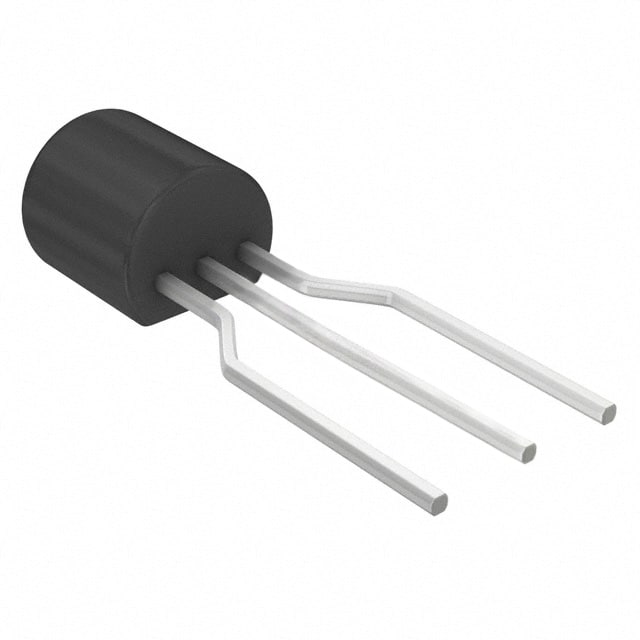Lihat spesifikasi untuk detail produk.

2N5400_D81Z
Product Overview
Category
The 2N5400_D81Z belongs to the category of small signal transistors.
Use
It is commonly used for amplification and switching of electronic signals in various applications.
Characteristics
- Small signal NPN transistor
- High current gain
- Low noise
- Low power dissipation
Package
The 2N5400_D81Z is typically available in a TO-92 package.
Essence
This transistor is essential for low-power amplification and switching circuits.
Packaging/Quantity
It is usually packaged in reels or tubes, with quantities varying based on manufacturer specifications.
Specifications
- Maximum Collector-Base Voltage: 160V
- Maximum Collector Current: 600mA
- Power Dissipation: 625mW
- Transition Frequency: 300MHz
- Operating Temperature Range: -65°C to 200°C
Detailed Pin Configuration
The 2N5400_D81Z transistor has three pins: 1. Base (B) 2. Emitter (E) 3. Collector (C)
Functional Features
- High current gain
- Low noise
- Suitable for low-power applications
- Fast switching speed
Advantages
- Versatile usage in amplification and switching circuits
- Low power dissipation
- Wide operating temperature range
Disadvantages
- Limited maximum collector current compared to some other transistors
- Relatively lower transition frequency
Working Principles
The 2N5400_D81Z operates based on the principles of bipolar junction transistors, utilizing the flow of charge carriers to amplify or switch electronic signals.
Detailed Application Field Plans
This transistor is widely used in: - Audio amplifiers - Signal processing circuits - Switching circuits - Oscillator circuits
Detailed and Complete Alternative Models
Some alternative models to the 2N5400_D81Z include: - 2N4401 - BC547 - 2N2222
In conclusion, the 2N5400_D81Z is a versatile small signal transistor suitable for various low-power electronic applications, offering high current gain and low noise characteristics. Its compact TO-92 package and wide operating temperature range make it an ideal choice for many circuit designs.
[Word Count: 298]
Sebutkan 10 pertanyaan dan jawaban umum terkait penerapan 2N5400_D81Z dalam solusi teknis
What is the 2N5400_D81Z transistor used for?
- The 2N5400_D81Z is a general-purpose PNP transistor commonly used in amplification and switching applications.
What are the key specifications of the 2N5400_D81Z transistor?
- The 2N5400_D81Z has a maximum collector current of 600mA, a maximum collector-base voltage of 160V, and a maximum power dissipation of 625mW.
How can I identify the pinout of the 2N5400_D81Z transistor?
- The pinout of the 2N5400_D81Z transistor is typically identified as the emitter (E), base (B), and collector (C) pins.
What are some common circuit configurations using the 2N5400_D81Z transistor?
- Common circuit configurations include common-emitter amplifiers, switch circuits, and voltage regulators.
What are the typical operating conditions for the 2N5400_D81Z transistor?
- The 2N5400_D81Z transistor is typically operated within a temperature range of -55°C to 150°C and at a maximum voltage and current specified in its datasheet.
Can the 2N5400_D81Z be used in high-frequency applications?
- While the 2N5400_D81Z can be used in moderate frequency applications, it may not be suitable for high-frequency designs due to its transition frequency limitations.
What are some common alternatives to the 2N5400_D81Z transistor?
- Alternatives include the 2N3906, BC557, and BC558 transistors, which have similar characteristics and can be used as substitutes in many applications.
How do I calculate the biasing resistors for the 2N5400_D81Z transistor in an amplifier circuit?
- The biasing resistors can be calculated using the desired operating point, transistor beta, and the supply voltage to establish the appropriate biasing conditions.
What are the typical gain characteristics of the 2N5400_D81Z transistor?
- The transistor's current gain (hFE) typically ranges from 100 to 300, depending on the operating conditions and biasing.
Are there any specific considerations for using the 2N5400_D81Z in high-temperature environments?
- It's important to ensure proper heat sinking and derating of the transistor's power dissipation to maintain reliable operation in high-temperature environments.

